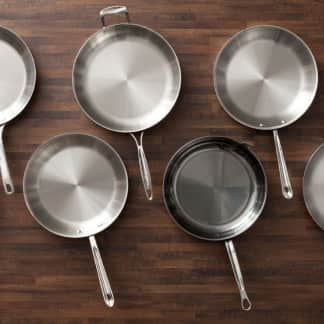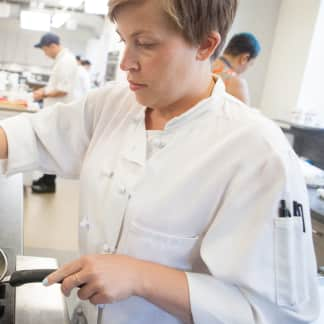The best sauté pans heat evenly, have a broad cooking surface, and are comfortable to hold and pour from. We liked many of the pans we tested, but we found a favorite in the Made In Stainless Clad Saute Pan. It had a roomy cooking surface and browned food evenly, and its moderately high walls corralled splatters. We also liked its comfortable handle.
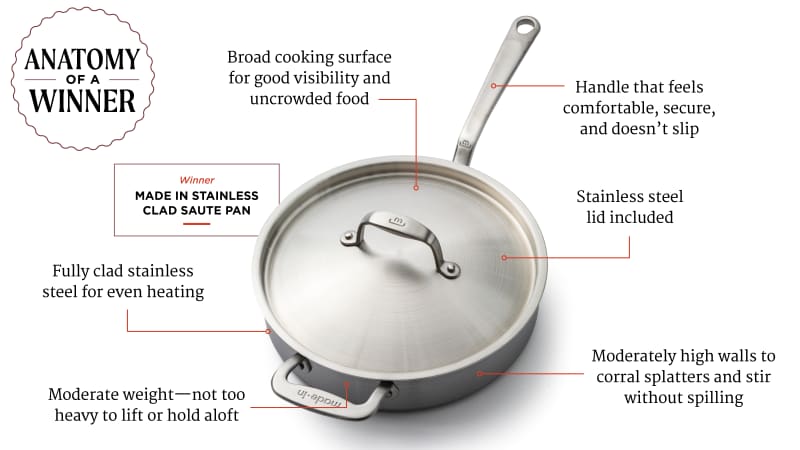
Sauté pans offer the broad cooking surface of a skillet but unlike skillets, they have moderately high, L-shaped walls. Their walls are high enough to contain food and prevent spills as you stir but low enough that it’s easy to reach in with tongs to flip food. They’re one of our go-to pans for braising, shallow frying, and cooking large amounts of greens.
All the pans in our lineup are made from stainless steel, which is good for developing fond, the flavorful bits of food left behind after browning that serve as the base for pan sauces. Stainless steel can withstand high temperatures: The pans in our lineup are ovensafe to at least 500 degrees Fahrenheit. The pans we tested hold between 3 and 3.5 quarts, offering a cooking surface similar to that of a 12-inch skillet.
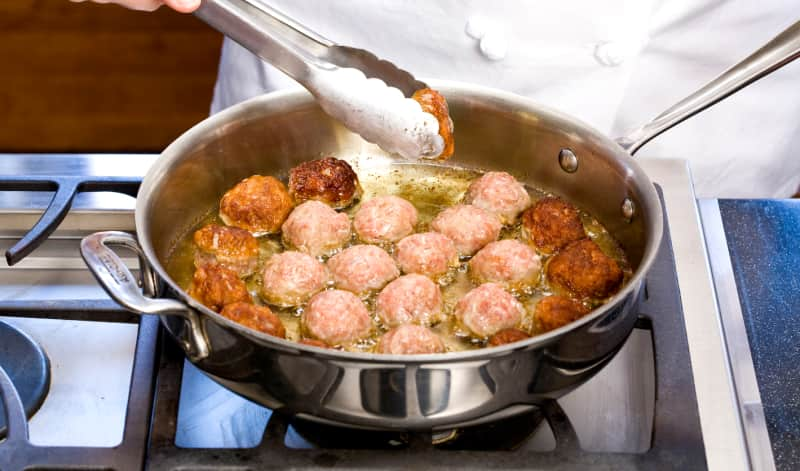
The pans have another important thing in common: They’re fully clad, which we know from previous testings that we prefer to disk-bottom pans. Fully clad pans are made of layers of aluminum sandwiched between stainless steel. Aluminum quickly conducts heat, while stainless steel retains heat well. During our testing, we identified other key features that mean the difference between a good sauté pan and a great sauté pan.
What to Look For
- A Broad Cooking Surface: Our favorite pans had wide cooking surfaces that measured between 9.5 and 9.8 inches. A large cooking surface meant we could cook more food at once. Meatballs weren’t crowded together, and there was room for us to reach in with tongs and rotate them. Greens cooked quicker because they could be spread in a thinner layer.

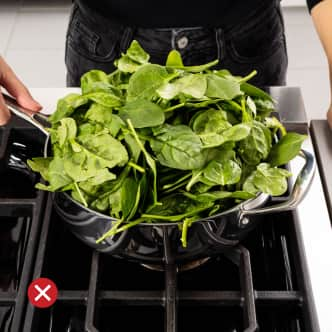
Pans with wider cooking surfaces fit one pound of spinach more easily. Plus, spinach cooked quicker because it could be spread in a thinner layer.
- Moderately High Walls: Walls on our pans ranged from 2 to nearly 3 inches tall, but we preferred pans with walls that were just under 2.5 inches, which not only contained the food we cooked in them but also made it easy to access the cooking food.
- Moderate Weight: When transferring food to a plate, pouring off fat before making a pan sauce, or moving a full sauté pan to the oven, it’s important that the pan be comfortable to lift. Moderately heavy pans were ideal. They felt sturdy, but we could still lift them and pour from them without too much strain.
- A Long, Straight, Comfortable Handle: We preferred pans with long, straight handles; they were the most comfortable to use. A dedicated place to rest our thumbs was a bonus.
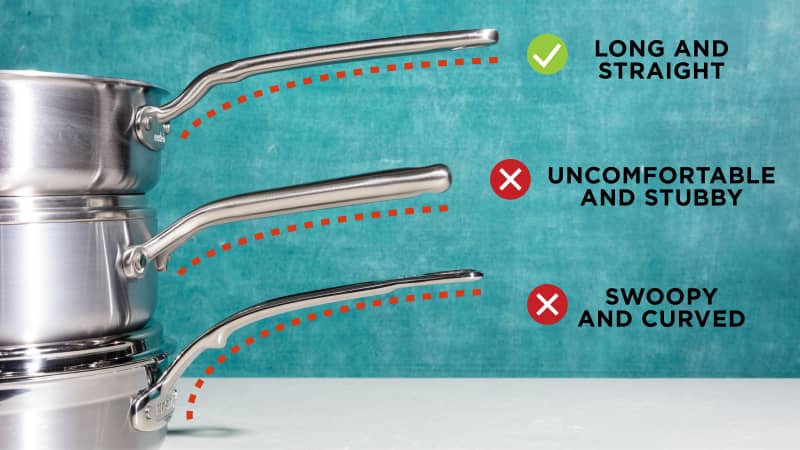
- A Helper Handle: Helper handles, located opposite the main handle, provide support when a pan filled with food is too heavy to lift with one hand. Although we don’t find helper handles necessary when cooking with a skillet, we usually cook more food in a sauté pan, and the ingredients often include liquids, so the contents can be much heavier and more unwieldy. Moving the one pan without a helper handle into and out of the oven felt unstable and we worried about dropping the pan and its contents.

Nice to Have
- Dishwasher-Safe: Most of the pans we tested are dishwasher-safe. While we generally recommend hand-washing pans in order to help extend their lives, we like the convenience of tossing a pan in the dishwasher too.
What to Avoid
- Narrow Cooking Surfaces: Cooking surfaces that measured 8.5 inches felt small. Meatballs were more crowded in these pans, and it was harder to fit a pound of spinach in them.
- Very Low or High Walls: When stirring rice in a pan with 2-inch-high walls, we lost some food over the edge. However, pans with higher walls didn’t always perform better. When cooking in those with the highest walls, we had to awkwardly navigate our tongs over the walls to turn the meatballs. These pans reminded us more of saucepans.

- Heavy or Light Pans: Heavy pans were challenging to pour from. Carrying them to and from the oven was also a chore, especially when their lids were in place. Lighter pans were easiest to maneuver, but our lightest pan, which weighs less than 3 pounds, seemed dinky when compared to more substantial models. And more importantly, this lightweight pan retained two nickel-size dents from abuse testing.
- Short or Dramatically Curved Handles: While the handles on our favorite models measured between 8 and 8.7 inches long, one pan’s handle, at just 7.3 inches long, was short and stubby, and its end pressed uncomfortably into the palm of our hand. The relatively large circumference of this handle didn’t feel as secure in our hands either. Handles of other models that curved drastically away from the pans were also uncomfortable to hold and made the pans feel heavier.

- A Glass Lid: All of the pans we tested came with a well-fitting lid. Most were stainless steel, but one was made of heavy glass. At 1 pound, 9 ounces, it weighed almost twice as much as our lightest stainless-steel lid. We like the idea of being able to monitor our food without removing the lid, but our view was obscured by steam or condensation, so the glass offered no real advantage. Lastly, the glass lid was only ovensafe to 425 degrees, while the stainless-steel lids were ovensafe to at least 500 degrees.
The Tests
- Make Swedish Meatballs
- Make Mexican Rice
- Recruit additional tester to sauté spinach
- Recruit additional tester to fill each pan with 8 cups of water and then pour water into empty bowl
- Wash each pan by hand after each test
- Dishwasher-safe models: Wash twice in dishwasher
- Heat to nearly 500 degrees and then plunge into ice water and check for warping
- Whack three times on concrete cinder block and evaluate denting
How We Rated
- Performance: Pans that produced evenly browned food and good fond for flavorful pan sauces rated higher.
- Ease of Use: We liked pans with moderate weight that were evenly balanced between the pan and the handle. Pans with a spacious cooking surface and moderately high walls rated higher. Pans also rated higher if their handles were comfortable to grip firmly and didn’t feel insecure or slippery.
- Cleanup/Durability: We considered how easy the pans were to clean after cooking. Pans rated higher if they remained level and without large dents at the end of testing.

















